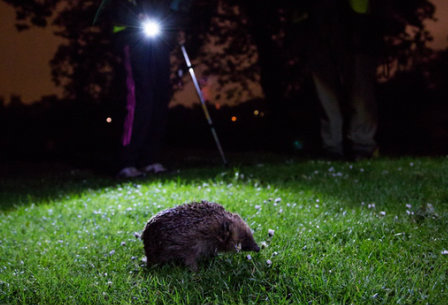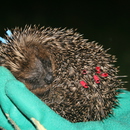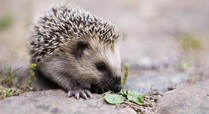Unearthing the secret lives of hedgehogs in London’s Regent’s Park

We're working in partnership with The Royal Parks and The Zoological Society of London (ZSL) to find out why Regent’s Park is the only central London Royal Park to have retained a resident hedgehog population whilst hedgehog numbers are declining nationwide. Find our more about the scientific study and our research methods here.
In July and September, we brought together expert scientists, wildlife conservation organisations and local volunteers to conduct a range of night-time surveys. The aims of this research were to help:
- find out more about the size of the hedgehog populations in Regent's Park and observe their movements, feeding and nesting habits
- develop habitat recommendations to help conserve the hedgehog population in Regent’s Park and inform other parks and urban open spaces around the country
- educate the local community and park users about the resident hedgehog population so that they will help protect and support them in the future.
Dr Nigel Reeve, one of the UK’s leading hedgehog experts says:
This is a fantastic opportunity to investigate this population for which we had no information at all. For the first time, we can obtain some real data which allows us to understand how hedgehogs use the park”.
Survey Results
A total of 45 individual hedgehogs were found during the survey indicating a significant population in a park of this size – 1.6 km2 (160ha). Some of the animals were seen to cover an area of up to 30,000 m2 (3ha) in a single night and their preferred park habitat appeared to be rough grassland and shrubby areas.
Far from ambling slowly, hedgehogs are actually quite athletic travelling up to 1.5 km, nearly one mile, per night according to the survey’s initial findings. In the scale of a hedgehog’s body size and average leg length (10 cm), that’s the human equivalent of a man with a 32-inch inside leg walking 12 km (7.5 miles) every day and more than 50 miles a week. Alternatively, 1.5 km is three stops on the Underground between Regent’s Park and The Angel, Islington!
Julia Clark, The Royal Park’s Head of Ecology said:
For Regent’s Park to be the only central London Park with a viable population of hedgehogs is a significant find. We know that urban landscapes are increasingly important to hedgehogs. The results from this survey such as habitat preferences will enable us to create more hedgehog friendly habitats across London’s Royal Parks. Everyone can help reverse the trend of this declining species by planting native hedges, leaving ‘wild’ areas in gardens or simply by making small holes in walls or fences to connect gardens.”
Hedgehog heroes
More than 60 volunteers, aged from 20 to 70 years old, known as ‘Hedgehog Heroes’, joined eminent wildlife biologists Dr Nigel Reeve and Professor John Gurnell and the team to help undertake this unique hedgehog survey.
 Hedgehog Heroes’ learnt to spotlight the prickly animals with specialised LED torches and hi-tech tracking equipment was used to monitor and observe hedgehogs during the night without intrusion. Some of the hedgehogs had bespoke lightweight radios and miniature GPS transmitters attached for one week to track their movements around the park. The team also positioned footprint tunnels in strategic locations with Frankfurters as bait to tempt in the hedgehogs. A dozen night cameras then captured their ‘sniffing’ and foraging behaviour.
Hedgehog Heroes’ learnt to spotlight the prickly animals with specialised LED torches and hi-tech tracking equipment was used to monitor and observe hedgehogs during the night without intrusion. Some of the hedgehogs had bespoke lightweight radios and miniature GPS transmitters attached for one week to track their movements around the park. The team also positioned footprint tunnels in strategic locations with Frankfurters as bait to tempt in the hedgehogs. A dozen night cameras then captured their ‘sniffing’ and foraging behaviour.
Kat Ellis, aged 25, lives in Holborn and says the project was the first time she’d seen a hedgehog in the city. Kat said:
Being involved in this study was so eye-opening. I never realised that these amazing little mammals literally live on my doorstep. The highlight was definitely handling a real-life hedgehog (something I never imagined I would do!) I now see the parks through different eyes and will do all I can to help support them.”
This partnership research project also includes supporting partners Central Royal Parks Wildlife Group, Peoples’ Trust for Endangered Species and Untyped, and has been made possible thanks to a private gift given to the Royal Parks Foundation.
Professor John Gurnell from Queen Mary, University of London will present final research findings from the survey in Spring 2015.
- Loading latest tweets...

